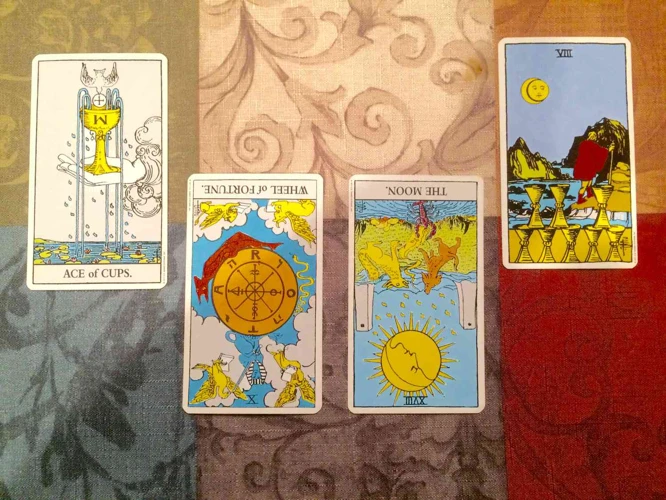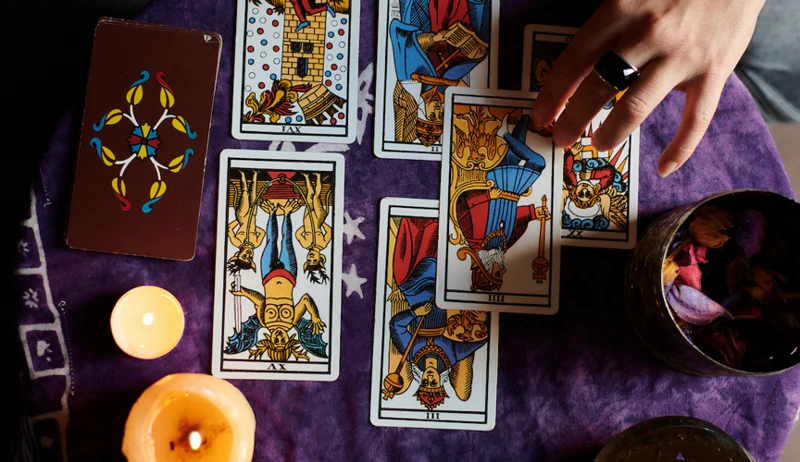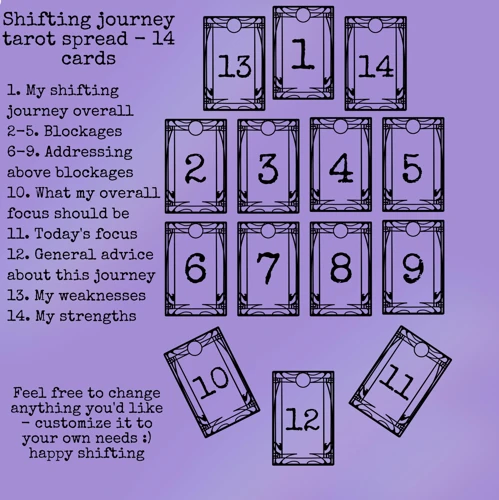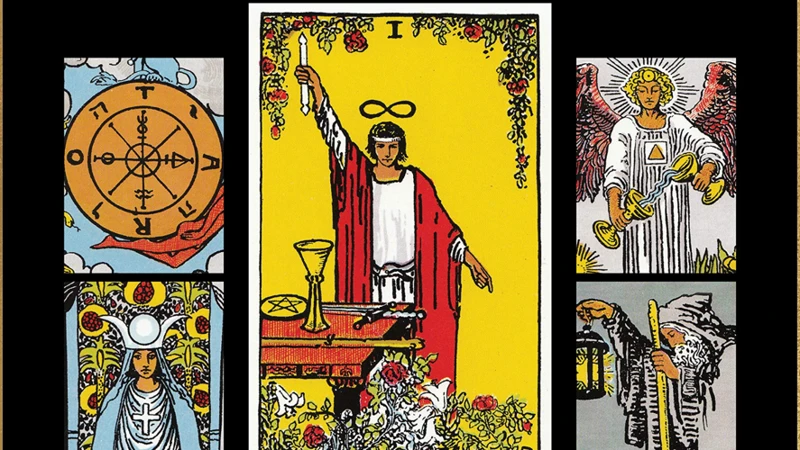The world of tarot cards is filled with rich symbolism, allowing us to tap into our intuition and gain insights into our lives. While many tarot readers focus solely on upright cards, incorporating reversed tarot cards into your spreads can add a new layer of depth and complexity. Reversed cards offer expanded interpretations and can provide valuable guidance when navigating obstacles or seeking advice. In this article, we will explore the significance of reversed tarot cards, the benefits of incorporating them into your readings, and provide step-by-step guidance on how to use and interpret reversed cards in your tarot spreads. So grab your tarot deck and let’s dive into the fascinating world of reversed tarot cards.
Contents
Understanding Reversed Tarot Cards

|
What are reversed tarot cards? Reversed tarot cards, also known as inverted or upside-down cards, are tarot cards that appear in a reading in a reversed position. When the card is flipped upside down, its energy and meaning may be influenced or altered. This creates an opportunity to explore different perspectives and interpretations during a tarot reading. While there are varying opinions on the significance of reversed cards, they are generally seen as a reflection of blocked energy, delays, or challenges in the area represented by the card. |
|
The significance of reversed tarot cards Reversed tarot cards hold a unique significance in tarot readings. They invite us to delve deeper into the nuances of a situation and provide a glimpse into the hidden aspects of our lives. Reversals can indicate that the energy of the card is not fully expressed or that there are obstacles and internal conflicts to consider. They offer a more complex narrative, allowing for a more nuanced interpretation of the cards. Reversed cards can bring attention to areas that require healing, growth, or additional attention in our lives. |
What are reversed tarot cards?
| Reversed tarot cards, also known as inverted or upside-down cards, are tarot cards that appear in a reading with their traditional upright position reversed. This means that when the card is drawn, it appears upside down or reversed. The reversal of the card alters its energy and meaning, creating a distinct interpretation for the card in the reading. It is important to note that not all tarot practitioners incorporate reversed cards into their readings, as interpretations may vary. However, for those who do use reversed cards, they can add a layer of complexity and depth to the reading. Reversed cards provide an opportunity to explore the challenges, obstacles, or blocked energies in the area represented by the card. They can shed light on unexpressed or hidden aspects of the situation or the individual being read for. By incorporating reversed tarot cards, readers can tap into a wider range of symbolism and insights, enhancing the overall reading experience. To learn more about the impact of reversed tarot cards, you can read our previously published article on the subject. |
The significance of reversed tarot cards
The significance of reversed tarot cards lies in their ability to provide a more nuanced and complex reading. When a tarot card appears in a reversed position, it indicates that the energy or message of the card is being blocked or is operating at a lower vibrational level. This can suggest challenges, delays, or a need for introspection in the area represented by the card. Reversed tarot cards prompt us to look beyond the surface and consider the hidden aspects of a situation. They encourage us to explore the root causes of any obstacles or conflicts we may be facing. Rather than viewing reversals as inherently negative, they can be seen as opportunities for growth and transformation. By recognizing the significance of reversed tarot cards and incorporating them into our readings, we gain a deeper understanding of the intricate dynamics at play in our lives. For a more comprehensive understanding of reversed tarot card meanings, refer to our guide on reversed tarot card meanings. Embracing this balance of upright and reversed cards allows for a more holistic interpretation and a well-rounded reading that encompasses both the light and shadow aspects of our experiences.
Benefits of Incorporating Reversed Tarot Cards

|
Added depth and complexity Incorporating reversed tarot cards into your spreads adds a new layer of depth and complexity to your readings. It allows you to explore the full range of energies and possibilities within a card. Reversed cards offer a different perspective, revealing hidden aspects of the situation at hand. This additional dimension can lead to a more nuanced understanding of the reading and provide valuable insights into the complexities of life. |
|
Expanded interpretations When reversed cards are included, the interpretation of tarot spreads becomes more expansive. They present new meanings and narratives that are not accessible through upright cards alone. Reversed tarot cards can offer alternative viewpoints, highlighting obstacles, challenges, or areas that require attention and growth. By incorporating reversed cards, you can tap into a wider range of interpretations and uncover deeper insights in your readings. |
Added depth and complexity
When incorporating reversed tarot cards into your spreads, one of the key benefits is the added depth and complexity they bring to your readings. Reversed cards have a way of shedding light on the hidden aspects and underlying dynamics of a situation. They open up a whole new layer of interpretation, allowing you to explore a broader range of possibilities and insights. By including reversed cards, you are able to tap into the subtle energies and subtle shifts that may be at play. This added dimension provides a more comprehensive understanding of the situation at hand and can offer a more nuanced perspective to your querents. By embracing the reversed cards, you create a balanced approach to your readings, encouraging growth, self-reflection, and a deeper connection with the tarot. So, if you’re looking to bring more depth and complexity to your readings, don’t shy away from incorporating reversed tarot cards. They hold the key to unlocking a wealth of knowledge and understanding.
Expanded interpretations
When incorporating reversed tarot cards into your spreads, one of the major benefits is the expanded interpretations they offer. Reversed cards add a new layer of depth and complexity to the reading, allowing for a more nuanced understanding of the situation at hand. They provide insights into the hidden aspects, subconscious influences, and underlying energies surrounding a particular card. By considering the reversed position, you can uncover additional meanings and potential outcomes that may not have been apparent with upright cards alone. This expansion of interpretation allows for a more holistic and comprehensive reading that takes into account both the positive and challenging aspects of a situation. It encourages you to explore different perspectives and consider alternative possibilities, ultimately leading to a more well-rounded understanding of the cards and their messages. So, embrace the opportunity to incorporate reversed tarot cards into your readings and embark on a journey of expanded interpretations and deeper insights into your life’s journey.
Preparing Your Tarot Deck

|
Cleansing and charging your tarot deck Before incorporating reversed tarot cards into your readings, it’s important to cleanse and charge your tarot deck. This helps to clear any residual energy and establish a fresh connection with your cards. There are various methods you can use to cleanse your deck, including smudging with sage, placing the cards in moonlight or sunlight, or using crystals such as clear quartz. Once cleansed, you can charge your deck by holding it in your hands and visualizing positive energy flowing into each card. This process helps to attune the cards to your own energy and intention, ensuring a more accurate and personalized reading. |
|
Marking the reverse side of the cards To easily identify which cards are reversed during a reading, you may choose to mark the reverse side of the cards. This can be done by using a small symbol, drawing a line, or placing a sticker on the back of each card. Keep in mind that the marking should not interfere with the shuffle or make the cards too slippery. By marking the reverse side, you can quickly distinguish between upright and reversed cards, facilitating a smoother reading process. Alternatively, if you prefer not to mark your cards, you can simply rely on your intuition to identify the orientation of each card as you lay them out in a spread during a reading. |
Cleansing and charging your tarot deck
|
Cleansing and charging your tarot deck is an essential step before incorporating reversed tarot cards into your spreads. Cleansing removes any energetic residue or influences from previous readings, ensuring a clear and open channel for intuitive guidance. To cleanse your deck, you can use methods such as smudging with sage, placing the cards under moonlight or sunlight, or using crystals with cleansing properties like selenite or clear quartz. Charging your deck involves infusing it with your energy and intention. You can achieve this by holding the deck and visualizing it being filled with positive energy and vibrations. Some tarot readers also choose to create a ritual, such as saying a prayer or affirmation, to further enhance the connection with the cards. It’s important to establish a personal cleansing and charging routine that resonates with you and your practice. By maintaining the energy balance of your tarot deck, you create an optimal environment for accurate and insightful readings. |
Marking the reverse side of the cards
|
To incorporate reversed tarot cards into your tarot spreads, you can mark the reverse side of your cards to distinguish them visually. This can be done by using a specific symbol or drawing on the card backings. There are a few methods you can use to mark your cards:
It’s important to select a marking method that works best for you and doesn’t damage the cards. Take care when marking the cards to ensure the marks are consistent and clear. Additionally, if you prefer to keep your cards pristine, you can use separate reversed tarot cards specifically designated for this purpose, or use an online tarot deck that allows for reversed card readings. Remember, marking the reverse side of the cards is a personal choice, and if you find it unnecessary, you can still incorporate reversed cards in your tarot spreads without marking them. |
Incorporating Reversed Tarot Cards in Simple Spreads

One simple tarot spread that can be adapted to incorporate reversed tarot cards is the past, present, and future spread. In this spread, three cards are drawn and laid out in a line to represent the past, present, and future respectively. To incorporate reversed cards, shuffle the deck while keeping in mind your intention to include reversals. As you draw the cards, pay attention to any that come out reversed and place them in their respective positions. The reversed cards can provide insights into past patterns that need to be acknowledged, present challenges that require attention, or potential obstacles that may arise in the future. The reversed cards in this spread serve as indicators of areas that may need careful consideration and may offer suggestions for finding balance. Remember to trust your intuition and explore the connections between the reversed and upright cards to gain a holistic understanding of your reading. (source: /revtarotbalance/)
The yes or no spread is another simple and effective way to incorporate reversed tarot cards into your readings. In this spread, you ask a specific question and draw a single card to get a yes or no answer. When using reversals, you can assign additional meanings to the upright and reversed positions. For example, an upright card may signify a strong “yes,” while a reversed card may indicate a “no” or a need for further consideration. Alternatively, you can interpret the reversed card as a “maybe” or a need for caution or adjustment in your approach. The presence of a reversed tarot card in a yes or no spread can provide valuable insights into the nuances and complexities of the situation at hand. Remember that intuitive interpretations are key in this spread, so trust your instincts and let the reversed cards guide you in uncovering the answers you seek.
Past, present, and future spread
A popular tarot spread for incorporating reversed cards is the Past, Present, and Future spread. This spread offers insights into how past experiences and current circumstances may be shaping your future. To begin, shuffle the deck thoroughly while focusing on your question or intention. Place the cards facedown and draw three cards. The first card represents the past, the second card represents the present, and the third card represents the future. When interpreting the cards, pay attention to any reversed cards that appear.
In this spread, a reversed card in the past position may indicate unresolved issues, past traumas, or patterns that are influencing your current situation. It suggests that there may be unfinished business or emotional baggage from the past that needs to be addressed before you can move forward.
A reversed card in the present position can suggest blockages, challenges, or hidden factors affecting your current circumstances. It indicates that there may be obstacles or resistance in the present that you need to navigate through or overcome.
Lastly, a reversed card in the future position may suggest potential setbacks or delays in achieving your desired outcome. It serves as a gentle reminder to remain flexible and adaptable as you work towards your goals.
Remember, the interpretation of reversed cards can vary based on the context of the reading, the surrounding cards, and your intuition. Take note of any intuitive impressions or symbols that stand out to you when interpreting the cards. Trust your inner guidance and allow the reversed cards to add a deeper layer of meaning and insight to your tarot readings.
Yes or no spread
|
The Yes or No spread is a simple yet powerful tarot spread that can be enhanced by incorporating reversed tarot cards. This spread is designed to provide a direct answer to a specific question. To begin, shuffle your tarot deck and ask your question. Lay out three cards in a row, representing the past, present, and future. In a traditional Yes or No spread, upright cards are associated with a positive or affirmative response, while reversed cards indicate a negative or opposing answer. However, when reversed cards are included in this spread, they add an extra layer of insight and complexity to the reading. Reversed cards can suggest a need for caution or a delay in the manifestation of the desired outcome. They can also serve as a warning or an opportunity for growth and introspection. Pay attention to the subtle nuances and messages conveyed by the reversed cards in this spread, as they can provide valuable guidance and a deeper understanding of the situation at hand. |
Advanced Techniques for Using Reversed Tarot Cards

|
Reverse card as an obstacle When incorporating reversed tarot cards into your readings, one advanced technique is to view the reverse card as an obstacle or challenge that needs to be overcome. Pay attention to the symbolism and imagery on the card and consider how it relates to the overall spread. The reversed card may suggest areas where you need to address limiting beliefs, fears, or blockages in order to achieve your desired outcome. Use the reverse card as a guide to identify the specific obstacles that may be hindering your progress and explore strategies to overcome them. |
|
Reverse card as advice Another advanced technique for using reversed tarot cards is to interpret them as advice or guidance. In this approach, the reversed card can provide insights into alternative paths, perspectives, or actions that you can take to navigate a situation. Pay attention to the intuitive flashes or messages you receive when you see a reversed card. It may be encouraging you to consider a different approach, make a shift in your mindset, or consider taking a step back to reassess before moving forward. Trust your intuition and allow the reversed card to guide you in making decisions or taking action. |
Reverse card as an obstacle
|
When a reversed tarot card appears in a spread, it often indicates an obstacle or challenge that needs to be addressed. The reversed position may suggest that the energy of the card is blocked or inhibited in some way, creating difficulties or resistance in the associated area of life. For example, if the reversed Five of Cups appears in a reading, it could suggest that the querent is struggling to move on from past heartbreak or disappointment. It may signify a need to confront and release negative emotions before progress can be made. Reversed cards as obstacles offer insight into areas where growth or resolution is needed, urging the querent to face their challenges head-on and find a way to overcome them. |
Reverse card as advice
|
When a reversed tarot card appears in a reading, it can also serve as valuable advice or guidance. Reversed cards often indicate areas of our lives where we may need to make adjustments, change our perspective, or approach a situation differently. They encourage us to look inward and consider alternative solutions or approaches to challenges we may be facing. The advice provided by a reverse card can be seen as an invitation to explore different possibilities, let go of old patterns, or seek a new perspective. It is important to approach these cards with an open mind and consider how their advice can positively impact our lives. |
Interpreting Reversed Tarot Cards
|
Intuition and personal symbolism When interpreting reversed tarot cards, it’s important to tap into your intuition and personal symbolism. While traditional tarot meanings can provide a framework, your own intuitive insights are invaluable in understanding the message of a reversed card. Pay attention to the emotions, images, and thoughts that arise when you see a card in reverse. Trust your instincts and allow your intuition to guide you in unlocking the deeper meanings within the cards. |
|
Traditional meanings with a twist While reversed tarot cards can offer alternative interpretations, it doesn’t mean that the traditional meanings should be ignored. The reversed position simply adds a layer of complexity and a different perspective to the card’s overall message. Consider how the energy of the card may be blocked or hindered in this reversed position. Explore the opposing qualities or challenges that may be influencing the card’s symbolism. By blending traditional meanings with the unique insights gained from the reversal, you can form a more comprehensive understanding of the card’s significance in your reading. |
Intuition and personal symbolism
|
When interpreting reversed tarot cards, it is crucial to tap into your intuition and personal symbolism. While there are traditional meanings associated with each card, the reversed position allows for a more subjective approach. Pay close attention to the emotions, images, and impressions that arise when you see a reversed card. Trust your instincts and allow your intuition to guide you in understanding the message it holds for you or the querent. |
| Our personal symbolism also plays a significant role in interpreting reversed cards. Each individual may have a unique understanding or association with certain symbols or imagery. For example, if the reversed card depicts water, it may represent emotions, intuition, or the subconscious for one person, while for another, it could symbolize flexibility, adaptability, or a need for cleansing and purification. Your personal connection to the symbols in the cards can provide valuable insights that go beyond the traditional meanings. Embrace your own symbolism and allow it to deepen your interpretation of the reversed tarot cards. |
Traditional meanings with a twist
|
When working with reversed tarot cards, it’s important to remember that the traditional meanings of the upright cards can be given a unique twist when they appear reversed. The reversed position often suggests a shift or alteration in the energy of the card, which in turn affects its interpretation. For example, a card that typically represents success or abundance in its upright position might indicate a delay or temporary setback when reversed. Similarly, a card associated with challenges or obstacles could signify a resolution or breakthrough when appearing upside down. The reversed position adds layers of complexity and invites tarot readers to consider alternative perspectives and possibilities when interpreting the cards. |
Conclusion
|
Incorporating reversed tarot cards into your tarot spreads can bring a whole new dimension to your readings. These upside-down cards offer added depth and complexity, expanding the interpretations and insights they provide. By preparing your tarot deck and marking the reverse side of the cards, you can easily integrate reversed cards into your spreads. Simple spreads like the past, present, and future spread or the yes or no spread can be enhanced by including reversed cards. Additionally, advanced techniques such as using reverse cards as obstacles or advice can further enrich the reading. When it comes to interpreting reversed tarot cards, both intuition and traditional meanings play a role, allowing you to tap into your personal symbolism and explore alternative interpretations. Embrace the power of reversed tarot cards and allow them to guide you towards a greater understanding and deeper insights in your tarot practice. |
Frequently Asked Questions
FAQs About Understanding Reversed Tarot Cards
Q: Are reversed tarot cards always negative?
A: No, reversed tarot cards are not inherently negative. They simply provide a different perspective or indicate challenges that need to be addressed.
Q: Can reversed tarot cards completely change the meaning of a reading?
A: Reversed cards can add layers of complexity but they don’t completely change the meaning. They offer additional insights and highlight different aspects of the situation.
Q: How do I know if a card should be read as reversed?
A: Generally, if a card is upside down when drawn, it is read as reversed. Some readers choose to shuffle their decks to include reversed cards while others interpret the reversals based on intuition.
Q: Do reversed cards always indicate challenges?
A: While reversed cards can suggest challenges, they can also indicate hidden opportunities, internal reflection, or the need for a different approach.
Q: Should I focus more on upright or reversed card meanings?
A: It’s important to consider both upright and reversed meanings to get a comprehensive understanding of the cards. Pay attention to the context of the reading and trust your intuition.
Q: Can I choose to not use reversed cards in my readings?
A: Yes, you have the choice to exclude reversed cards from your readings if you prefer. However, incorporating them can provide a more well-rounded interpretation.
Q: Are there reversed card meanings specific to each tarot deck?
A: Some tarot decks may have specific interpretations for reversed cards, while others may follow more traditional meanings. It’s helpful to refer to the guidebook or study the deck’s symbolism.
Q: Can a card be both upright and reversed in the same reading?
A: No, a card cannot be both upright and reversed in the same reading. It will either appear upright or reversed based on its orientation when drawn.
Q: How can I improve my interpretation of reversed tarot cards?
A: Practice and experience are key to improving your interpretation of reversed cards. Take note of patterns, explore different interpretations, and develop your intuitive connection with the cards.
Q: Can reversed tarot cards indicate timing?
A: Yes, reversed tarot cards can offer insights into delays, blocks, or the need for patience in relation to timing within a reading.






